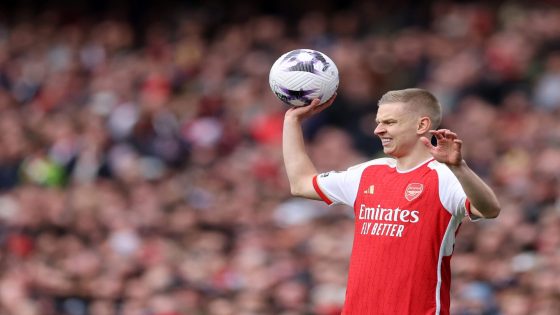As Oleksandr Zinchenko was substituted in the 87th minute of Arsenal’s 2-0 defeat to Aston Villa, he was met with the sound of jeers from some sections of the home support.
The discord would have disappointed Mikel Arteta, who is insistent on the club presenting a unified front. But on this day, for the manager to admonish the fans who vented their frustrations would have been hypocritical. In the course of those 87 minutes, there had been several instances where Zinchenko’s actions caused Arteta to throw his hands to his head or slap his thigh in irritation.
This was a difficult game for a player who is becoming increasingly divisive among the Arsenal support. In a season in which Arteta has worked so hard to eliminate on-field jeopardy, Zinchenko is beginning to feel like a relic of last season’s more chaotic team.

Arteta cut a frustrated figure as Arsenal slipped to a damaging defeat (Shaun Botterill/Getty Images)
Analysis of Zinchenko’s strengths and weaknesses tends to be somewhat black and white — ‘attacking good, defending bad’. There is truth in that stark summary, but there are shades of grey to consider, too. His one-on-one defending is more robust than that suggests. For a player not blessed with great athleticism and who began his career as a playmaker, Zinchenko can be an effective tackler and header of the ball. According to Opta, he succeeds in 61 per cent of his duels. Of Arsenal’s outfield players, only Thomas Partey can better that.
He’s not perfect in possession, either. His outrageous talent comes with a dangerous degree of confidence. His willingness to try things that other players wouldn’t is an asset, until it suddenly isn’t — see his attempt to beat Youri Tielemans inside his own penalty box, an instance that very nearly led to the opening goal.
But there have been periods when Zinchenko has been the joker in Arteta’s hand, a player who grants his manager enormous tactical flexibility. In any given phase of the game, the 27-year-old can be a left-back, a central midfielder, a number 10 or a left-winger. It’s for that reason, as well as his quality in possession, that Arteta is willing to tolerate his defensive lapses.

GO DEEPER
The Briefing: Arsenal 0 Aston Villa 2: Unai Emery’s side leave Arsenal’s title bid in the balance
At times last season, Zinchenko seemed to give Arsenal an extra man, moving untracked into midfield to create overloads. When the opposition did follow him, it left Gabriel Martinelli one-on-one against his full-back.
But tactical innovations do not retain the element of surprise for long in the Premier League. Opposition analysts are now well aware of Zinchenko’s party trick. For a long time, the good he offered Arsenal comfortably outweighed the bad. It now feels as if that balance may be beginning to shift.
There are even signs he is becoming less essential to Arsenal’s build-up. Last season, he comfortably led the team for successful passes which end in the final third per 90 minutes, averaging 22. This season he has been superseded by both Jorginho (23) and Martin Odegaard (23).
Unai Emery would certainly have looked at that flank as an area where Villa could win the battle. The speed of Moussa Diaby, later replaced by Leon Bailey, was ideally suited to threatening the space Zinchenko casually vacates.

Zinchenko confronts Bailey, who came off the bench to open the scoring (Stuart MacFarlane/Arsenal FC via Getty Images)
Zinchenko has two years remaining on his Arsenal contract — typically the moment where clubs decide whether to renew or sell. At a time when Arsenal have negotiated new deals for the likes of Bukayo Saka, William Saliba and Martin Odegaard with impressive efficiency, they have not yet entered significant talks with Zinchenko.
Arsenal’s to-do list for the summer includes the acquisition of a new left-back. That is in itself quite remarkable given that the club already have six potential left-backs on the books. As well as Zinchenko there are Jakub Kiwior, Takehiro Tomiyasu, Jurrien Timber and the on-loan pair of Kieran Tierney and Nuno Tavares. Arteta has more depth at his disposal in this position than in any other, yet still seems to be searching for an ideal solution.
Perhaps he needs a specialist. A common demand for Arteta in his first few transfer windows was “specificity” — players with the attributes to meet his precise criteria for each position. Kiwior is naturally a centre-half; Timber and Tomiyasu are both more comfortable on the right or in the middle. Zinchenko, in his soul, is more a No 10 than a defender. Maybe Arsenal would benefit from the addition of a left-back who was just that; no more, no less.
In the short-term, Arteta faces a big decision on who to field at left-back against Bayern Munich on Wednesday.
He selected Kiwior for the first leg, but chose to substitute the Polish international at half-time after a torrid 45 minutes up against Leroy Sane. Timber is expected to play for Arsenal’s Under-21s, as well as in a behind closed doors friendly, before being considered for first-team action.
Tomiyasu seems to be the most well-rounded candidate for the role, but he has not started in the league since returning from injury in March. Zinchenko does not often complete 90 minutes. As well as a specialist, Arteta needs a left-back who can stay fit.
For all his struggles against Villa, it would be no great surprise if Arteta stuck with Zinchenko at the Allianz Arena. It is fascinating to see a manager so eager to reduce jeopardy be intoxicated by a full-back whose playing style comes with an inherent element of risk. Arteta does not come across as a gambler, but he still can’t help himself from betting on Zinchenko — an irresistible yet imperfect solution in what is becoming a problem position.
Whether Arteta’s faith extends beyond the summer, however, remains to be seen.
(Top photo: Catherine Ivill – AMA/Getty Images)



